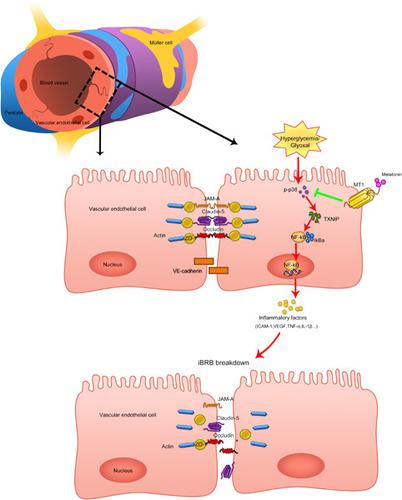当前位置:
X-MOL 学术
›
J. Cell. Physiol.
›
论文详情
Our official English website, www.x-mol.net, welcomes your
feedback! (Note: you will need to create a separate account there.)
Melatonin maintains inner blood‐retinal barrier via inhibition of p38/TXNIP/NF‐κB pathway in diabetic retinopathy
Journal of Cellular Physiology ( IF 4.5 ) Pub Date : 2021-01-11 , DOI: 10.1002/jcp.30269 Lei Tang 1 , Chaoyang Zhang 1, 2 , Qian Yang 1 , Hai Xie 1 , Dandan Liu 1 , Haibin Tian 1 , Lixia Lu 1 , Jing-Ying Xu 1 , Weiye Li 1, 3 , Guoxu Xu 4 , Qinghua Qiu 2, 5 , Kun Liu 2, 5 , Dawei Luo 2, 5 , Guo-Tong Xu 1 , Jingfa Zhang 1, 2, 5
Journal of Cellular Physiology ( IF 4.5 ) Pub Date : 2021-01-11 , DOI: 10.1002/jcp.30269 Lei Tang 1 , Chaoyang Zhang 1, 2 , Qian Yang 1 , Hai Xie 1 , Dandan Liu 1 , Haibin Tian 1 , Lixia Lu 1 , Jing-Ying Xu 1 , Weiye Li 1, 3 , Guoxu Xu 4 , Qinghua Qiu 2, 5 , Kun Liu 2, 5 , Dawei Luo 2, 5 , Guo-Tong Xu 1 , Jingfa Zhang 1, 2, 5
Affiliation

|
The pathophysiology of diabetic retinopathy (DR) was complex. Under hyperglycemic conditions, the release of proinflammatory cytokines and the adhesion of leukocytes to retinal capillaries contribute to endothelial damage and the subsequent increase in vascular permeability resulting in macular edema. Melatonin, produced in the retina to regulate redox reactions and dopamine metabolism, plays protective roles against inflammation and oxidative stress. Considering its anti‐inflammatory and antioxidative properties, melatonin was speculated to exert beneficial effects in DR. In this study, we characterized the protective effects of melatonin on the inner blood–retinal barrier (iBRB), as well as the possible mechanisms in experimental DR. Results showed that in diabetic rat retinas, the leakage of iBRB and the expression of inflammatory factors (VEGF, TNF‐α, IL‐1β, ICAM‐1, and MMP9) increased dramatically, while the expression of tight junction proteins (ZO‐1, occludin, JAM‐A, and claudin‐5) decreased significantly. The above changes were largely ameliorated by melatonin. The in vivo data were confirmed in vitro. In addition, the protein expressions of p38 MAPK, NF‐κB, and TXNIP were upregulated significantly in diabetes and were downregulated following melatonin treatment. Melatonin could maintain the iBRB integrity by upregulating the expression of tight junction proteins via inhibiting p38/TXNIP/NF‐κB pathway, thus decreasing the production of inflammatory factors. This study may shed light on the development of melatonin‐based DR therapy.
中文翻译:

褪黑激素通过抑制糖尿病视网膜病变中的 p38/TXNIP/NF-κB 通路维持内部血视网膜屏障
糖尿病视网膜病变(DR)的病理生理学非常复杂。在高血糖条件下,促炎细胞因子的释放以及白细胞与视网膜毛细血管的粘附导致内皮损伤以及随后血管通透性增加,导致黄斑水肿。褪黑激素在视网膜中产生,调节氧化还原反应和多巴胺代谢,对炎症和氧化应激发挥保护作用。考虑到褪黑激素的抗炎和抗氧化特性,推测褪黑激素对 DR 具有有益作用。在这项研究中,我们描述了褪黑激素对内血视网膜屏障 (iBRB) 的保护作用,以及实验性 DR 中的可能机制。结果显示,在糖尿病大鼠视网膜中,iBRB的渗漏和炎症因子(VEGF、TNF-α、IL-1β、ICAM-1和MMP9)的表达显着增加,而紧密连接蛋白(ZO-1)的表达显着增加。 、occludin、JAM-A 和claudin-5)显着下降。褪黑激素在很大程度上改善了上述变化。体内数据在体外得到证实。此外,p38 MAPK、NF-κB 和 TXNIP 的蛋白表达在糖尿病中显着上调,而在褪黑激素治疗后下调。褪黑素可以通过抑制p38/TXNIP/NF-κB通路上调紧密连接蛋白的表达来维持iBRB的完整性,从而减少炎症因子的产生。这项研究可能有助于揭示基于褪黑素的 DR 疗法的发展。
更新日期:2021-01-11
中文翻译:

褪黑激素通过抑制糖尿病视网膜病变中的 p38/TXNIP/NF-κB 通路维持内部血视网膜屏障
糖尿病视网膜病变(DR)的病理生理学非常复杂。在高血糖条件下,促炎细胞因子的释放以及白细胞与视网膜毛细血管的粘附导致内皮损伤以及随后血管通透性增加,导致黄斑水肿。褪黑激素在视网膜中产生,调节氧化还原反应和多巴胺代谢,对炎症和氧化应激发挥保护作用。考虑到褪黑激素的抗炎和抗氧化特性,推测褪黑激素对 DR 具有有益作用。在这项研究中,我们描述了褪黑激素对内血视网膜屏障 (iBRB) 的保护作用,以及实验性 DR 中的可能机制。结果显示,在糖尿病大鼠视网膜中,iBRB的渗漏和炎症因子(VEGF、TNF-α、IL-1β、ICAM-1和MMP9)的表达显着增加,而紧密连接蛋白(ZO-1)的表达显着增加。 、occludin、JAM-A 和claudin-5)显着下降。褪黑激素在很大程度上改善了上述变化。体内数据在体外得到证实。此外,p38 MAPK、NF-κB 和 TXNIP 的蛋白表达在糖尿病中显着上调,而在褪黑激素治疗后下调。褪黑素可以通过抑制p38/TXNIP/NF-κB通路上调紧密连接蛋白的表达来维持iBRB的完整性,从而减少炎症因子的产生。这项研究可能有助于揭示基于褪黑素的 DR 疗法的发展。











































 京公网安备 11010802027423号
京公网安备 11010802027423号